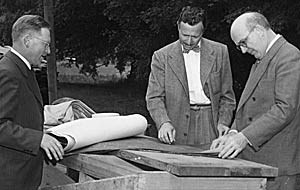
new chemistry building in 1948 with chemistry professor
Arthur F. Scott. (photo courtesy Reed College archives)
In May of this year, Restore Oregon hosted a tour of homes designed by Pietro Belluschi in the Portland area. For people who saw these beautiful designs and left wanting more mid-century Modernism, you are in luck: you can find more Belluschi nestled in amongst the array of architecturally interesting buildings on the Reed College campus in SE Portland.
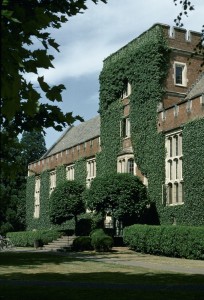
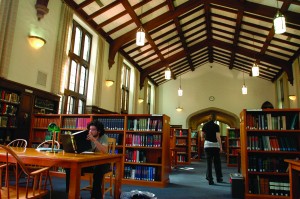
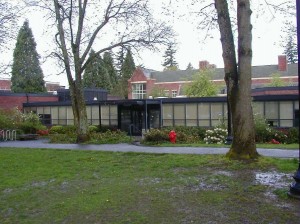
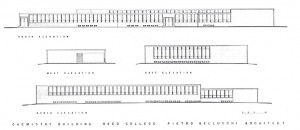


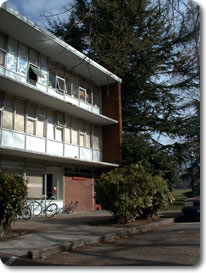
In 1911, Reed College had its first classes in a building in downtown Portland. By January of that year, a committee had chosen A.E. Doyle as the primary architect for the college’s future campus, and by 1912 the college’s first buildings, Old Dorm Block and Eliot Hall, had been built. Doyle designed and added buildings to the campus over the years, including the Woodstock Language Houses and what was once the women’s dorm, Anna Mann Hall. However, Doyle died in 1928 and it was under architect Pietro Belluschi that Reed, due to new and improved academics and an increasing student body, experienced a period of rapid growth in the post-war years.
About ten years ago, Reed underwent an evaluation of buildings and environmental features as part of a campus expansion project. The evaluation resulted in a Heritage Master Plan identifying priority areas of campus that should be protected as Reed continues to grow and change. Obvious candidates for protection were the original, most recognizable Reed buildings: Eliot Hall and Old Dorm Block, both of which achieved landmark status in the plan.
These were followed closely by two Belluschi buildings: the Hauser Memorial Library, a neo-Gothic structure which Belluschi completed after the death of A.E. Doyle, and the apparently unassuming but actually groundbreaking Psychology Building (known as the Chemistry Building prior to 1995). Finally, the Foster-Scholz and MacNaughton dormitories, which Belluschi designed along with Skidmore, Owings, and Merrill in the mid-1950s, were his last contributions to the Reed campus and achieved secondary status in the plan.
During my time as a Reed student, I loved the Hauser Memorial Library for obvious reasons. It had grotesques, for goodness’ sake, and I was a medieval and early modern history major. I also, however, particularly liked the Psych Building. I enjoyed the glass-filled entrances and how the simple metal framework was pleasantly offset and softened by the foliage around the building. Hidden as it is behind the science buildings, bushes, and trees, even when I had a class there everyday, I consistently felt that I was stumbling across it, a Modernist Narnia hidden at the back of the campus wardrobe.
I also always assumed the Psych Building was fairly new. Like the “New Dorms” (completed in 2008) where I lived my freshman year, it had that feeling about it: big windows, clean lines, and a position outside of my main campus travel radius. I had no idea that this building was one of the originals, intentionally set out on its own at the far reach of campus, a manifestation of what Belluschi decided would be more of a linear rather than a quadrangle campus plan. Constructed in 1948, the building was designed as early as 1945, making it one of the earliest Modernist designs in the country. It was the first of its style on a college campus, and drawings of it existed even prior to the construction of Belluschi’s Equitable Building. When it first arose, the Psych Building stood independent and unabashed, with no trees to hide behind: a stark experiment.
Just as Belluschi’s original Psych Building, library, and dormitories underwent remodeling, changes, and additions over the years, so too did Belluschi’s style during his time as Reed’s architect, and these buildings stand as an embodiment of that transformation. Begin at the Hauser Memorial Library to see Belluschi’s earliest, classical college work for Reed in Doyle’s style, then head to the Psychology building to see where he decided to try something totally different. Finally, visit the Foster-Scholz and MacNaughton dormitories to see some of his final work with Reed. Twenty-five years of Pietro Belluschi, all within a ten-minute walk.


One Reply to “Reed College: 25 Years of Belluschi Designs”
Comments are closed.